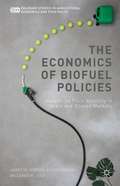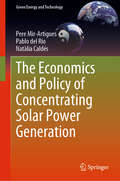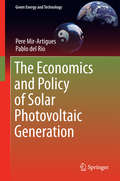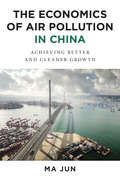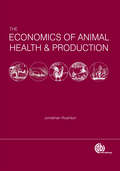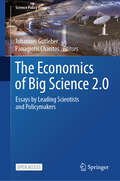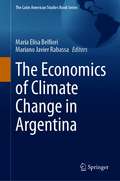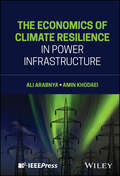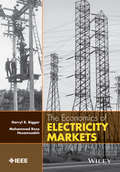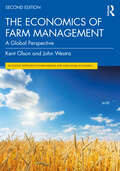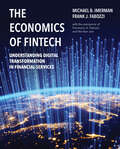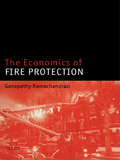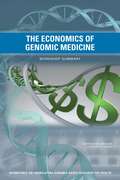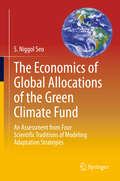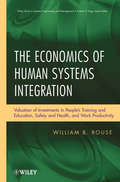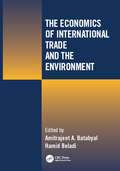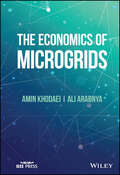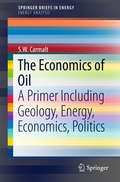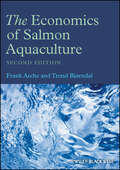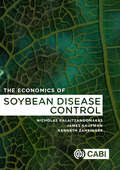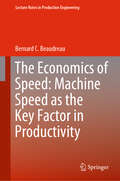- Table View
- List View
The Economics Of Biofuel Policies
by Harry De Gorter Dusan Drabik David R. JustThe global food crises of 2008 and 2010 and the increased price volatility revolve around biofuels policies and their interaction with each other, farm policies and between countries. While a certain degree of research has been conducted on biofuel efficacy and logistics, there is currently no book on the market devoted to the economics of biofuel policies. The Economics of Biofuel Policies focuses on the role of biofuel policies in creating turmoil in the world grains and oilseed markets since 2006. This new volume is the first to put together theory and empirical evidence of how biofuel policies created a link between crop (food grains and oilseeds) and biofuel (ethanol and biodiesel) prices. This combined with biofuel policies role in affecting the link between biofuels and energy (gasoline, diesel and crude oil) prices will form the basis to show how alternative US, EU, and Brazilian biofuel policies have immense impacts on the level and volatility of food grain and oilseed prices.
The Economics and Policy of Concentrating Solar Power Generation (Green Energy and Technology)
by Pere Mir-Artigues Pablo del Río Natàlia CaldésThis book provides an up-to-date analysis of state-of-the-art concentrating solar power (CSP) generation. It focuses on the economic analysis of CSP generation technologies as well as the policies that have been and are being used around the globe to support it. The book describes the industrial sectors whose products make up the solar field, including the traditional manufacturers of turbines and generators.The authors provide the main theoretical tools needed to comprehend the costs of CSP technologies compared to other competing technologies (both conventional and renewable) and discuss the conceptual rationale behind creating public support for these technologies and the costs of various promotional techniques. Further, the book examines the concepts from different disciplinary traditions in economics (including environmental, innovation, industrial and public), which are then combined and integrated for an analysis of the costs and policies of CSP electricity.Addressing the main findings and the challenges for future CSP, the book is a valuable resource for researchers and practitioners. It is also of use to industrial engineers, as it identifies the features of the sector’s supply chain value, rooted in and supported by an industrial economics approach.
The Economics and Policy of Solar Photovoltaic Generation
by Pere Mir-Artigues Pablo Del RíoThis book provides an up-to-date, rigorous analysis of the state of the art of solar photovoltaic (PV) generation. It focuses on the economic analysis of solar PV generation technologies as well as the policies that have been devised and implemented around the globe to support it. It provides the main theoretical tools for understanding the cost of these technologies, and discusses them from both a historical and comparative perspective with respect to other competing technologies (both conventional and renewable). In addition, it presents the conceptual rationale to maximize reader insights into whether and how public support for these technologies is justified as well as the consequences for the economy of different promotion measures. Integrating concepts from different economics disciplines (environmental economics, innovation economics, industrial economics and public economics) into a coherent basis for the analysis of the costs and policies for solar PV electricity, it provides an update to the literature to reflect recent advances in and deployments of solar electricity and the drastic reduction in associated costs.
The Economics of Air Pollution in China: Achieving Better and Cleaner Growth
by Jun MaSuffocating smog regularly envelops Chinese metropolises from Beijing to Shanghai, clouding the future prospect of China's growth sustainability. Air pollutants do not discriminate between the rich and the poor, the politician and the "average Joe." They put everyone's health and economic prosperity at risk, creating future costs that are difficult to calculate. Yet many people, including some in China, are concerned that addressing environmental challenges will jeopardize economic growth. In The Economics of Air Pollution in China, leading Chinese economist Ma Jun makes the case that the trade-off between growth and environment is not inevitable. In his ambitious proposal to tackle severe air pollution and drastically reduce the level of so-called PM 2.5 particles—microscopic pollutants that lodge deeply in lungs—Ma Jun argues that in targeting pollution, China has a real opportunity to undertake significant structural economic reforms that would support long-term growth. Rooted in rigorous analyses and evidence-based projections, Ma Jun's "big bang" proposal aims to mitigate pollution and facilitate a transition to a greener and more sustainable growth model.
The Economics of Animal Health and Production
by Jonathan RushtonThis book draws on both extensive literature and experience in animal health economics and livestock issues in Europe, Asia, Africa and Latin America. It provides comprehensive coverage of the history of livestock and animal health economics, theory and tools for the economics of animal health and production, a review of the application of economics to animal diseases and health problems, and worldwide examples of economic analysis and policy making.
The Economics of Big Science 2.0: Essays by Leading Scientists and Policymakers (Science Policy Reports)
by Panagiotis Charitos Johannes GutleberThe second volume of open access essays builds upon the success of the initial installment, "The Economics of Big Science (© 2021, 978-3-030-52390-9, Open Access book as well)," delving deeper into the tangible socio-economic value generated by fundamental science missions and elucidating the various ways in which this benefit is realized. This collection showcases contributions that stem from socio-economic impact studies conducted on the activities of Research Infrastructures. These studies were presented and discussed by the authors during a dedicated session on the "Economics of Big Science" at the headquarters of the European Space Agency (ESA) in Paris in May 2023, organized by EIROforum. The authors, affiliated with prominent universities, research centers, and international research organizations, actively contribute to an international collaborative effort. Their aim is to develop strategies and policies that ensure fundamental scientific research in Europe translates into tangible and sustainable societal and economic benefits. This volume is intended to be a valuable resource for policymakers, funding agencies, scientists, and academics across diverse domains. It serves as a comprehensive reference for the evidence of socio-economic impact stemming from fundamental scientific research within Open Science, Research, and Innovation environments. Moreover, it equips stakeholders with evidence supporting the effectiveness of impact analysis and facilitates the design of best practices in this regard.
The Economics of Climate Change in Argentina (The Latin American Studies Book Series)
by Maria Elisa Belfiori Mariano Javier RabassaIn this volume, the contributors discuss some of the most remarkable global warming effects in Argentina and examine policies that Latin American countries could follow to achieve their individual climate goals. Climate change is one of the most pressing issues today. However, after many years of climate negotiations, the world has failed to introduce a common global policy. Differences in countries' climate agendas have led to unsuccessful efforts. Countries willing to pursue a climate policy have sought alternative strategies to mitigate and adapt to global warming's consequences within their jurisdiction. In this context, Latin American countries' role in shaping the regional climate agenda is yet to be explored. The book covers some papers from the well-received "First Workshop on Environmental Economics and Energy" in Argentina. Using data from Argentina, the contributors analyze the effects of global warming on agricultural yields and the impact of extreme weather on human health. From a global perspective, the contributors also describe the interactions between a reduction in carbon emissions, carbon emissions intensity, and economic growth; the role that trade policies can play to reduce carbon emissions; and the paradoxes that arise from promoting renewable energies in the region. The contributors also address the relationship between sustainability and economic growth; the private sector's role in shaping policies and providing sustainable solutions; and the Latin American challenges for the next generation. The book will be of interest to policy-makers, academics, researchers, and professionals worldwide working in climate change impacts and policy. It will also appeal to a general audience interested in climate change economics, its consequences, and the steps that countries in Latin America can take to move forward.
The Economics of Climate Resilience in Power Infrastructure
by Amin Khodaei Ali ArabnyaFull-scope economic perspectives on planning, operations management, and maintenance of climate resilience building measures in power infrastructure The Economics of Climate Resilience in Power Infrastructure sheds light on the engineering economics of climate adaptation in electric power infrastructure by covering the relevant decision-making processes involved in managing risk and resilience in these systems. The book offers a system-level perspective along with detailed modeling of the most pressing resilience issues, while also providing detailed numerical examples on small test systems throughout the text to help readers see the outcomes of models. The book starts with an introduction to risk management and the techno-economic considerations for resilience building measures in power systems. Next, economic concepts and mechanisms for managing climate risk in power systems are introduced. Afterward, an economic model for resilience investment in these systems against climate shocks is presented. The authors then discuss an economic asset management model for long-term resilience building in critical infrastructure assets. Subsequently, an economic model for operations management during disasters is proposed, followed by a model for post-disaster restoration. Written by a pair of distinguished thought leaders, the book explores other topics such as: Microgrid applications for decentralization, along with an economic model for resilience-oriented microgrid operations A deep defense framework for climate risk management in power systems, along with other factors influencing their operational and financial resilience Essential climate risk financing mechanisms and techno-economic factors in managing risk and resilience in the face of wildfires, heat waves, and hurricanes Steps for utility and infrastructure owners to recover from climate shocks and natural disasters, for the benefit of shareholders, ratepayers, and policymakers The Economics of Climate Resilience in Power Infrastructure is an essential resource on the subject for industry practitioners, R&D engineers, infrastructure planners, and graduate students seeking to incorporate the economics of resilience with engineering solutions to streamline the success of climate adaptation measures in the power and energy industry.
The Economics of Electricity Markets
by Darryl R. Biggar Mohammad Reza HesamzadehBridges the knowledge gap between engineering and economics in a complex and evolving deregulated electricity industry, enabling readers to understand, operate, plan and design a modern power system With an accessible and progressive style written in straight-forward language, this book covers everything an engineer or economist needs to know to understand, operate within, plan and design an effective liberalized electricity industry, thus serving as both a useful teaching text and a valuable reference. The book focuses on principles and theory which are independent of any one market design. It outlines where the theory is not implemented in practice, perhaps due to other over-riding concerns. The book covers the basic modelling of electricity markets, including the impact of uncertainty (an integral part of generation investment decisions and transmission cost-benefit analysis). It draws out the parallels to the Nordpool market (an important point of reference for Europe). Written from the perspective of the policy-maker, the first part provides the introductory background knowledge required. This includes an understanding of basic economics concepts such as supply and demand, monopoly, market power and marginal cost. The second part of the book asks how a set of generation, load, and transmission resources should be efficiently operated, and the third part focuses on the generation investment decision. Part 4 addresses the question of the management of risk and Part 5 discusses the question of market power. Any power system must be operated at all times in a manner which can accommodate the next potential contingency. This demands responses by generators and loads on a very short timeframe. Part 6 of the book addresses the question of dispatch in the very short run, introducing the distinction between preventive and corrective actions and why preventive actions are sometimes required. The seventh part deals with pricing issues that arise under a regionally-priced market, such as the Australian NEM. This section introduces the notion of regions and interconnectors and how to formulate constraints for the correct pricing outcomes (the issue of "constraint orientation"). Part 8 addresses the fundamental and difficult issue of efficient transmission investment, and finally Part 9 covers issues that arise in the retail market. Bridges the gap between engineering and economics in electricity, covering both the economics and engineering knowledge needed to accurately understand, plan and develop the electricity market Comprehensive coverage of all the key topics in the economics of electricity markets Covers the latest research and policy issues as well as description of the fundamental concepts and principles that can be applied across all markets globally Numerous worked examples and end-of-chapter problems Companion website holding solutions to problems set out in the book, also the relevant simulation (GAMS) codes
The Economics of Evaluating Water Projects: Hydroelectricity Versus Other Uses
by Per-Olov Johansson Bengt KriströmThis book presents research on a kind of water use conflicts that is becoming more and more common and important: How to best manage moving water in times of increasing demand for electricity as well as environmental services. How should decisions be made between water use for electricity generation or for environmental and recreational benefits? The authors develop a simple general equilibrium model of a small open economy which is used to derive a cost-benefit rule that can be used to assess projects that divert water from electricity generation to recreational and other uses (or vice versa). The cost-benefit rule is then applied to the specific case of a proposed change at a Swedish hydropower plant. The book provides a manual for the evaluation of river regulations which can easily be replicated in other studies.
The Economics of Farm Management: A Global Perspective (Routledge Textbooks in Environmental and Agricultural Economics)
by Kent Olson John WestraFuture farm managers need a range of tools and knowledge to run successful businesses, and this accessible textbook provides the required foundations from economics and management, applied to the farm context. In today’s world where farms are subject to ever-changing industrial, labor, demographic, and technological factors, this textbook provides a clear focus and methodology for business stability and growth. It covers core microeconomic and macroeconomic principles, plus the full range of management topics, from accounting and marketing to operations management and human resource management. It also covers family succession planning and farming mega-trends. This second edition has been updated with the latest data and literature, and gives deeper attention to sustainability and conservation. It also offers a broader range of examples, showcasing the diversity of farm types and farm sizes across the US and globally. Instructor materials are available as digital supplements. This textbook will be a valuable resource for courses in farm management, ranch management, agribusiness, and agricultural economics.
The Economics of FinTech: Understanding Digital Transformation in Financial Services
by Frank J. Fabozzi Michael ImermanA groundbreaking, comprehensive exploration of how FinTech innovation is reshaping finance.Technological innovation has shaped the role of finance since the introduction of the ATM in the 1960s, but never more consequentially than by the massive digital revolution in the financial services industry known as FinTech. The Economics of FinTech is a comprehensive introduction to this rapidly evolving and increasingly important domain, and a groundbreaking exploration of how FinTech is reshaping finance. Michael Imerman and Frank Fabozzi distill the dynamic developments of this multidisciplinary field into a cohesive, accessible guide that covers the economic underpinnings of FinTech innovation, framed within the established principles of financial intermediation, management theory, and data science. Coverage includes in-depth analysis of emerging technologies and innovations across various sectors of financial services as well as the entrepreneurial finance of FinTech such as funding, valuation, and startup management. The first book to examine the economic principles of FinTech innovation Comprehensive coverage of financial technologies across various sectors in financial services Ideal for undergraduate and graduate students as well as entrepreneurs, investors, and finance professionalsInstructor resources include solutions, slides, and case studies
The Economics of Fire Protection
by Ganapathy RamachandranThis important new book, the first of its kind in the fire safety field, discusses the economic problems faced by decision-makers in the areas of fire safety and fire precautions. The author considers the theoretical aspects of cost-benefit analysis and other relevant economic problems with practical applications to fire protection systems. Clear examples are included to illustrate these techniques in action. The work covers: * the performance and effectiveness of passive fire protection measures such as structural fire resistance and means of escape facilities, and active systems such as sprinklers and detectors * the importance of educating for better understanding and implementation of fire prevention through publicity campaigns and fire brigade operations * cost-benefit analysis of fire protection measures and their combinations, taking into account trade-offs between these measures. The book is essential reading for consultants and academics in construction management, economics and fire safety, as well as for insurance and risk management professionals.
The Economics of Genomic Medicine
by Institute of Medicine Steve Olson Board on Health Sciences Policy Adam C. Berger Roundtable on Translating Genomic-Based Research for HealthThe sequencing of the human genome and the identification of links between specific genetic variants and diseases have led to tremendous excitement over the potential of genomics to direct patient treatment toward more effective or less harmful interventions. Still, the use of whole genome sequencing challenges the traditional model of medical care where a test is ordered only when there is a clear indication for its use and a path for downstream clinical action is known. This has created a tension between experts who contend that using this information is premature and those who believe that having such information will empower health care providers and patients to make proactive decisions regarding lifestyle and treatment options. In addition, some stakeholders are concerned that genomic technologies will add costs to the health care system without providing commensurate benefits, and others think that health care costs could be reduced by identifying unnecessary or ineffective treatments. Economic models are frequently used to anticipate the costs and benefits of new health care technologies, policies, and regulations. Economic studies also have been used to examine much more specific issues, such as comparing the outcomes and cost effectiveness of two different drug treatments for the same condition. These kinds of analyses offer more than just predictions of future health care costs. They provide information that is valuable when implementing and using new technologies. Unfortunately, however, these economic assessments are often limited by a lack of data on which to base the examination. This particularly affects health economics, which includes many factors for which current methods are inadequate for assessing, such as personal utility, social utility, and patient preference. To understand better the health economic issues that may arise in the course of integrating genomic data into health care, the Roundtable on Translating Genomic-Based Research for Health hosted a workshop in Washington, DC, on July 17-18, 2012, that brought together economists, regulators, payers, biomedical researchers, patients, providers, and other stakeholders to discuss the many factors that may influence this implementation. The workshop was one of a series that the roundtable has held on this topic, but it was the first focused specifically on economic issues. The Economics of Genomic Medicine summarizes this workshop.
The Economics of Global Allocations of the Green Climate Fund: An Assessment from Four Scientific Traditions of Modeling Adaptation Strategies
by S. Niggol SeoThis book provides an incisive and economic assessment of the global warming adaptation policy and programs carved out by the United Nations Framework Convention on Climate Change, the Green Climate Fund (GCF), by relying on the four scientific traditions that have been advanced on the economics of adaptation to climate change in agricultural and natural resource enterprises. Substantially expanding and refocusing on the book Micro-behavioral Economics of Global Warming: Modeling Adaptation Strategies in Agricultural and Natural Resource Enterprises published by Springer in 2015, this book elucidates the theories and summarizes the empirical results and predictions from the four traditions of adaptation modelling: a microbehavioral economic model of adaptation, an agronomic-economic modelling, a statistical model of yield/productivity changes, and an ecosystem model of climate change impacts. The four modeling traditions are freshly analyzed and applied to the assessments of the 93+ GCF-funded projects and programs through the end of 2018.
The Economics of Groundwater Remediation and Protection (Integrative Studies in Water Management & Land Development)
by Ece Ozdemiroglu Paul E. HardistyEconomic literature is often too theoretical for engineers and policymakers to put into practical use, while scientific literature on the remediation of contaminated aquifers rarely considers costs and benefits. Written by a hydrogeologist and an economist, The Economics of Groundwater Remediation and Protection integrates economics and cost-benefit analysis tools with optimal protection and remediation strategies for groundwater resources.The book provides a thorough introduction of the concepts of groundwater flow and contaminant transport, and the basics of economic decision making techniques. It illustrates the types of risks and impacts caused by groundwater contamination, and the economic benefits of its remediation. The volume reviews a wide range of issues such as cost, implementation, and expectations of success for the latest remediation trends and techniques. The book shows how economic analysis can be used to determine how much we should pay for groundwater clean-up, and when spending too much - or too little - actually makes us all worse-off. The authors' step-by-step methodology for decision-making focuses on determining optimal remedial objectives, from containment to extensive cleanup, and the selection of least-cost alternatives. They use examples from their personal experience to illustrate the methodologies in action and put the issues into perspective.Combining the theoretical and practical aspects of science, policy, and economics, this book places the importance of groundwater remediation in the context of environmental economics, protection, and preservation. The Economics of Groundwater Remediation and Protection is also an excellent introduction to innovative solutions for funding remediation projects, education, and incentive programs, such as mitigation banking, land pollution credit schemes, and conservation credit alternatives.
The Economics of Human Systems Integration
by William B. RouseFundamental Economic Principles, Methods, and Tools for Addressing Human Systems Integration Issues and TradeoffsHuman Systems Integration (HSI) is a new and fundamental integrating discipline designed to help move business and engineering cultures toward more human-centered systems. Integrating consideration of human abilities, limitations, and preferences into engineering systems yields important cost and performance benefits that otherwise would not have been accomplished. In order for this new discipline to be effective, however, a cultural change--starting with organizational leadership--is often necessary.The Economics of Human Systems Integration explains the difficulties underlying valuation of investments in people's training and education, safety and health, and work productivity. It provides an overview of how the field of economics addresses these difficulties, focusing on human issues associated with design, development, production, operations, maintenance, and sustainment of complex systems.The set of thought leaders recruited as contributors to this volume collectively provides a compelling set of data and principles for assessing the economic value of investing in people, not just in general but in specific investment situations. The early chapters provide the contexts for HSI and investment analysis, illustrating the enormous difference context makes in how issues are best framed and analyzed. A host of practical methods and tools for investment valuation are then presented. Provided are:A variety of real-world applications of economic analysis ranging from military acquisition and automotive investment to healthcare and high-tech investments in general, in both the U.S. and abroadA range of economics-based methods and tools for cost analysis, cost-benefit analysis, and investment analysis, as well as sources of data for performing such analysesDiffering perspectives on economic decision-making, including a range of private sector points of view, as well as government and regulatory perspectivesIn addition, five real-world case studies illustrate how such valuations have been done and their major impacts on investment decisions. HSI professionals, systems engineers, and finance professionals who address investment analysis will appreciate the wide range of methods and real-life applications; senior undergraduates and masters-level graduate students will find this to be an excellent textbook that provides theory and supports practice.
The Economics of Integrated Pest Management of Insects
by John Mumford Jeffrey Alwang Rangaswamy Muniappan Steven E. Naranjo Zachary S. Brown Adeney De Bueno Peter C Ellsworth Bruna Magda Favetti George B Frisvold Yara A. Halasa-Rappel Erin W. Hodgson Menale Kassie George W Norton Roderick Rejesus Donald S. ShepherdMany biological studies on insect management do not consider economics or fundamental economic principles. This book brings together economists and entomologists to explain the principles, successes, and challenges of effective insect management. It highlights the importance of economic analyses for decision making and the feasibility of such approaches, and examines integrated pest management (IPM) practices from around the world with an emphasis on agriculture and public health. The book begins by establishing an economic framework upon which to apply the principles of IPM. It continues to examine the entomological applications of economics, specifically, economic analyses concerning chemical, biological, and genetic control tactics as well as host plant resistance and the cost of sampling and is illustrated with case studies of economic-based IPM programs from around the world.
The Economics of International Trade and the Environment
by Amitrajeet A. Batabyal Hamid BeladiIssues related to environmental protection and trade liberalization have moved to the forefront of international policy agendas. The Economics of International Trade and the Environment explores - from an economic standpoint - many of the questions that are germane in increasing our knowledge of environmental policy in the presence of international
The Economics of Microgrids
by Amin Khodaei Ali ArabnyaTHE ECONOMICS OF MICROGRIDS An incisive and practical exploration of the engineering economics of microgrids In The Economics of Microgrids, a pair of distinguished researchers delivers an expert discussion of the microeconomic perspectives on microgrids in the context of low-carbon, sustainable energy delivery. In the book, readers will explore an engineering economics framework on the investment decisions and capital expenditure analyses required for an assessment of microgrid projects. The authors also examine economic concepts and models for minimizing microgrid operation costs, including the cost of local generation resources and energy purchases from main grids to supply local loads. The book presents economic models for the expansion of microgrids under load and market price uncertainties, as well as discussions of the economics of resilience in microgrids for optimal operation during outages and power disturbances. Readers will also find: A thorough introduction to the engineering and economics of microgrids Comprehensive explorations of microgrid planning under uncertainty Practical discussions of microgrid expansion planning, operations management, and renewable energy integration Fulsome treatments of asset management and resilience economics in microgrids Perfect for senior undergraduate and graduate students as well as researchers studying power system design, The Economics of Microgrids will also benefit professionals working in the power system industry and government regulators and policymakers with an interest in microgrid technologies and infrastructure.
The Economics of Oil
by S. W. CarmaltThis book examines the ways that oil economics will impact the rapidly changing global economy, and the oil industry itself, over the coming decades. The predictions of peak oil were both right and wrong. Oil production has been constrained in relation to demand for the past decade, with a resulting four-fold increase in the oil price slowing the entire global economy. High oil prices have encouraged a small increase in oil production, and mostly from the short-lived "fracking revolution," but enough to be able to claim that "peak oil" was a false prophecy. The high oil price has also engendered massive exploration investments, but remaining hydrocarbon stocks generally offer poor returns in energy (the energy return on investment or EROI) and financial terms, and no longer replace the reserves being produced. As a result, the economically powerful oil companies are under great pressure, both financially and politically, as oil remains the backbone of the global economy. >Development scenarios and political pressure for growth as a means of solving economic woes both require more net energy, which is the amount of energy available after energy (and thus financial) inputs required for new sources to come on line are deducted. In today's economy, more energy usually means more oil. Although a barrel of oil from any source may look the same, "tight oil" and oil from tar sands require much higher prices to be profitable for the producer; these expensive sources have very different economic implications from the conventional oil supplies that underpinned economic growth for most of the 20th century. The role of oil in the global economy is not easily changed. Since currently installed infrastructure assumes oil, a change implies more than just substitution of an energy source. The speed with which such basic structural changes can be made is also constrained, and ultimately themselves dependent on fossil fuel inputs. It remains unclear how this scenario will evolve, and that uncertainty adds additional economic pressure to the investment decisions that must be made. "Drill baby drill" and new pipeline projects may be attractive politically, but projections of economic and associated oil production growth based on past performance are clearly untenable.
The Economics of Salmon Aquaculture (Fishing News Books #10)
by Frank Asche Trond BjorndalFirst published in 1990, The Economics of Salmon Aquaculture was the first book to systematically analyse the salmon aquaculture industry, from both a market and production perspective. Since publication of the first edition of this book, the salmon aquaculture industry has grown at a phenomenal rate, with salmon now being consumed in more than 100 countries worldwide. This second edition of a very popular and successful book brings the reader right up to date with all the major current issues pertaining to salmon aquaculture. Commencing with an overview of the production process in aquaculture, the following chapters provide in-depth coverage of the sources of the world’s supply of salmon, the growth in productivity, technological changes, environmental issues, markets, market structure and competitiveness, lessons that can be learnt from the culture of other species, optimal harvesting techniques, production planning, and investment in salmon farms. Written by Frank Ashe and Trond Bjørndal, two of the world's leading experts in the economics of aquaculture, this second edition of The Economics of Salmon Aquaculture provides the salmon aquaculture industry with an essential reference work, including a wealth of commercially important information. This book is also a valuable resource for upper level students and professionals in aquaculture and economics, and libraries in all universities and research establishments where these subjects are studied and taught should have copies of this important book on their shelves.
The Economics of Soybean Disease Control
by Nicholas Kalaitzandonakes James Kaufman Kenneth ZahringerWorldwide soybean crop yields can achieve USD$130 billion per year in farm-level sales, but around 13% of these yields are lost to disease. Effective disease management could generate significant economic benefits, and while disease management strategies do exist, their application remains limited among producers, often due to an incomplete understanding of disease incidence and severity, as well as perceived complexities of these strategies and a lack of information regarding success rates. This book presents an economic perspective on disease control, with an emphasis on producer choice among alternative technologies and potential changes in cropping systems. It provides an overview of global soybean diseases, their economic significance and management, and covers farm-level decision making, economic payoffs of alternative disease practices and key uncertainties. The book also outlines a global economic model that evaluates disease distribution and management implications. Key features include: - Extensive empirical case studies of soybean disease control, offering strategies for economically optimal management of diseases such as soybean seedling disease and root rot. - Analysis of economic factors to guide farm-level decision making. - Consideration of new technologies in disease management and their potential market-level impacts. This text is recommended for students and researchers in plant pathology and agricultural economics, as well as professionals in the soybean production industry.
The Economics of Soybean Disease Control
by Nicholas Kalaitzandonakes James Kaufman Kenneth ZahringerWorldwide soybean crop yields can achieve USD$130 billion per year in farm-level sales, but around 13% of these yields are lost to disease. Effective disease management could generate significant economic benefits, and while disease management strategies do exist, their application remains limited among producers, often due to an incomplete understanding of disease incidence and severity, as well as perceived complexities of these strategies and a lack of information regarding success rates. This book presents an economic perspective on disease control, with an emphasis on producer choice among alternative technologies and potential changes in cropping systems. It provides an overview of global soybean diseases, their economic significance and management, and covers farm-level decision making, economic payoffs of alternative disease practices and key uncertainties. The book also outlines a global economic model that evaluates disease distribution and management implications. Key features include: - Extensive empirical case studies of soybean disease control, offering strategies for economically optimal management of diseases such as soybean seedling disease and root rot. - Analysis of economic factors to guide farm-level decision making. - Consideration of new technologies in disease management and their potential market-level impacts. This text is recommended for students and researchers in plant pathology and agricultural economics, as well as professionals in the soybean production industry.
The Economics of Speed: Machine Speed as the Key Factor in Productivity (Lecture Notes in Production Engineering)
by Bernard C. BeaudreauThis is the first book to examine the “nuts and bolts” of production processes. It proposes a truly consilient approach to modeling production processes – one that goes beyond the vague principles found in standard economics – and provides details that are consistent with the applied mechanics and engineering literature. Providing a credible analysis of some of the most pressing questions of our era, such as the productivity slowdown and the information paradox, and bridging the gap between engineering, applied physics, economics, and management science, this book is a fascinating read for anyone interested in industry, the modern economy, and how physical factors constrain productivity growth.
